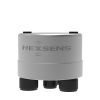Sequoia LISST-ABS Acoustic Sediment Sensor
Features
- Uses acoustic backscatter to measure the concentration of particles suspended in water
- Wide dynamic range of concentrations from 1mg/L to 30 g/L
- Plug-and-play interface with X-Series data loggers and telemetry systems
- Expedited repair and warranty service
- Lifetime technical support
- More
Overview
The Sequoia Scientific LISST-ABS is a single-point acoustic sediment sensor, designed to provide higher quality data than optical turbidity sensors. The LISST-ABS internally measures the Attenuation Corrected Backscatter (ACB). The ACB value is converted to an Uncalibrated Concentration (Cu) and then output. To convert the Uncalibrated Concentration to sediment concentration, a simple multiplier is required. The multiplier, or Cal Factor, is dependent on the specific type and size of sediment being measured. When a user recalibrates an instrument, this multiplier is updated.
Mechanics
The Sequoia Scientific LISST-ABS employs a high frequency of 8 MHz. Calibration of backscatter signal strength with sediment concentration remains nearly constant over a wide particle size range, ~40-500 microns. Over this size range, the Sequoia Scientific LISST-ABS calibration changes only about ~±30%. In contrast, over this same size range, optical turbidity sensors would change calibration by ~ ±600% over its mean value.
Remote Monitoring
The LISST-ABS sensor offers a plug-and-play interface to the NexSens X3 data loggers and telemetry systems. The X3 is available for pole-mount deployments with solar charging or connected to the SBP500 submersible alkaline battery pack for subsurface deployments.
- Frequency: 8 MHz
- Sample Volume: 10mm dia x 15mm L (located 5.5 cm in front of sensor)
- Resolution: 0.5 % of reading
- Range: 1 mg/L to 30 g/L (7 micron dust) or <20 g/L (200 micron sand)
- Calibration: Recommended with sediment samples
- Sensor Diameter: 2.00 in (5.08cm)
- Length: 13.25 in (33.65cm)
- Weight: 1 lb. (0.5Kg) in air; 0.5 lb. (0.22Kg) buoyant in water
- Transducer: 8mm dia, ceramic
- Power Supply: 9 to 18 VDC, 100 mA
- Maximum Depth: 100m
- Material: ABS Plastic
- Connector Type: Impulse MCBH-8-MP-SS
- Power on LED: Green, blink on update
- Sample Update Rate: 1Hz (average of 1000 measurements)
In The News
Monitoring and Facilitating Habitat Restoration Efforts in the Great Lakes
While human infrastructure, urbanization, and industrialization have advanced human societies, the natural environment has suffered due to constructed impediments and deteriorating architecture. In order to combat this degradation, habitat restoration programs across the US work to remove impairments and improve damaged waterways. [caption id="attachment_39162" align="aligncenter" width="940"] Barge electrofishing by state and federal employees prior to habitat restoration on Wiscoy Creek which is a tributary to the Genesee River. (Credit Thomas Hoffman)[/caption] Habitat Restoration Efforts in the Great Lakes Tom Hoffman, aquatic habitat restoration biologist in the Lower Great Lakes basin, directs restoration efforts within tributaries to Lake Erie, Lake Ontario, and the St.
Read MoreSustainable Fishing in Alaska: Protecting the Salmon Capital of the World through Research
In the far north, the Alaska Peninsula stretches away from the Last Frontier into the Pacific Ocean. A narrow strip of land dotted with freshwater lakes and intruded upon by ocean inlets–this unique region is intimately connected with the surrounding water. Nestled halfway down the peninsula's southern coast are the small villages of Chignik. The area has historically been home to the Aleut people and has been heavily reliant on fishing for centuries. Home to commercial and subsistence fishing today, Chignik continues to rely upon the salmon returns to the surrounding villages, which are supported by scientists working tirelessly to understand and steward these fish populations.
Read MoreNexSens X3 Data Logger Review
Extreme environments meet extreme design with the NexSens X3 Data Logger . The new logger offers the latest in real-time monitoring technology with wireless communication, a large plug-and-play sensor library and ultra-low power consumption, all in a waterproof marine-grade housing. The X3 is built to handle harsh weather, floods, high winds and rough seas, and it stands alone; no additional protective housing needed. With an operating temperature that ranges from -40°C to 70°C, the logger can withstand arctic environments and extreme heat. A conformal coating on the internal circuit board isolates it from moisture and humidity.
Read More






















